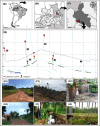Distribution and diversity of mosquitoes and Oropouche-like virus infection rates in an Amazonian rural settlement
- PMID: 33592052
- PMCID: PMC7886159
- DOI: 10.1371/journal.pone.0246932
Distribution and diversity of mosquitoes and Oropouche-like virus infection rates in an Amazonian rural settlement
Abstract
Mosquito diversity and disease transmission are influenced by landscape modifications, i.e., vectors and pathogens previously found only in forests are now found close to human environments due to anthropic changes. This study determined the diversity and distribution of mosquitoes in forest environments in order to analyze the potential vectors of Amazonian forest arboviruses. Mosquitoes were collected by 1) vertical stratification from forest canopy and ground areas using Hooper Pugedo (HP) light traps and human attraction and 2) horizontal stratification using HP light traps in peridomicile, forest edge, and forest environments near the Rio Pardo rural settlement, Amazonas, Brazil. A total of 3,750 mosquitoes were collected, representing 46 species. 3,139 individuals representing 46 species were sampled by vertical stratification. Both the Shannon-Weaver diversity index (H') and equitability (J') were higher in the canopy than on the ground. 611 individuals representing 13 species were sampled by horizontal stratification. H' decreased in the following order: forest edge > forest > peridomicile, and J' was greater at the forest edge and smaller in the peridomicile environment. Moreover, H' was higher for the human attraction collection method than the HP traps. A total of 671 pools were analyzed by RT-qPCR; three species were positive for Oropouche-like viruses (Ochlerotatus serratus, Psorophora cingulata, and Haemagogus tropicalis) and the minimum infection rate was 0.8%. The composition of mosquito species did not differ significantly between anthropic and forest environments in Rio Pardo. Some mosquito species, due to their abundance, dispersion in the three environments, and record of natural infection, were hypothesized to participate in the arbovirus transmission cycle in this Amazonian rural settlement.
Conflict of interest statement
The authors have declared that no competing interests exist.
Figures





References
-
- Vasconcelos PFC, Travassos da Rosa APA, Rodrigues SG, Travassos da Rosa ES, Dégallier N, Travassos da Rosa JFS. Inadequate management of natural ecosystem in the Brazilian Amazon region results in the emergence and reemergence of arboviruses. Cad Saúde Pública. 2001;17: S155–S164. 10.1590/s0102-311x2001000700025 - DOI - PubMed
Publication types
MeSH terms
LinkOut - more resources
Full Text Sources
Other Literature Sources
Medical
Research Materials
Miscellaneous

